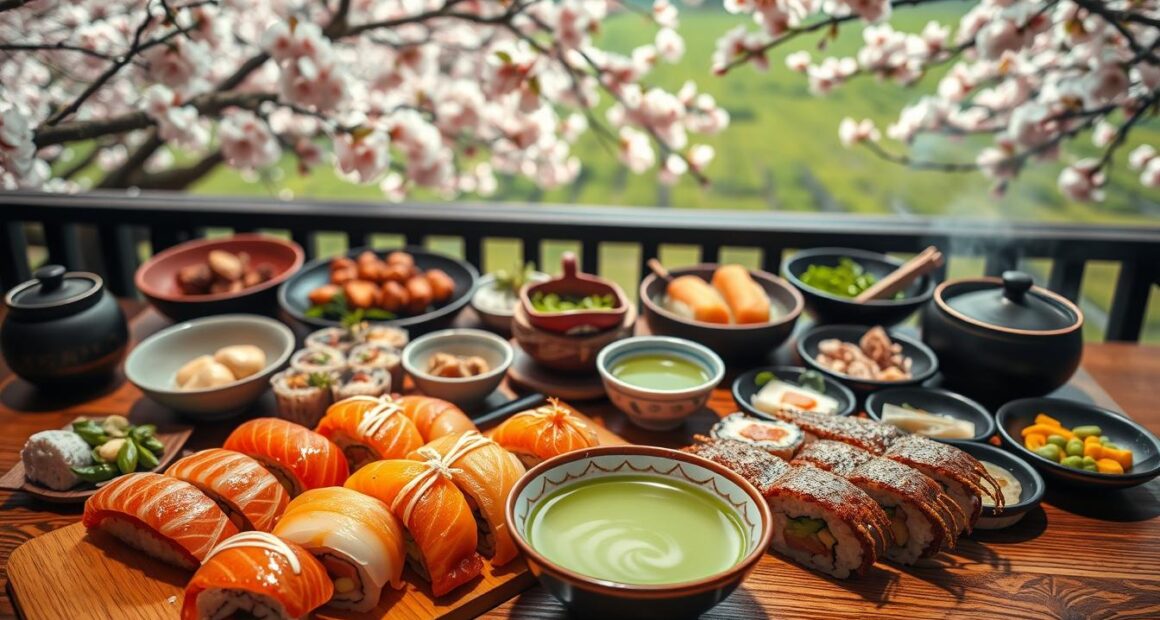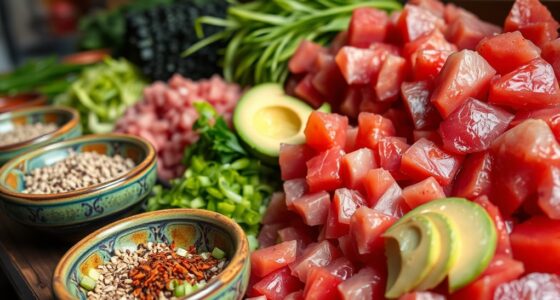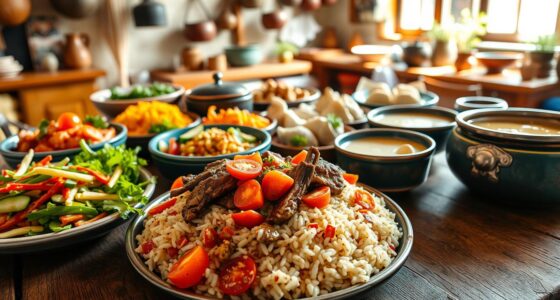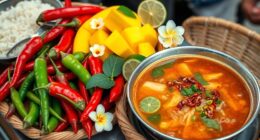Have you ever, with a single bite, felt transported to another world? That’s the magic of Japanese cuisine, where each dish tells a story steeped in tradition and crafted with love. From the moment you first savor fresh sushi, with its delicate balance of flavors and textures, to the warmth of a steaming bowl of ramen that wraps around you like a hug on a cold day, Japanese culinary treasures have a way of resonating deep within us. The beauty of this cuisine is not only in its presentation but also in its immense respect for fresh ingredients, which come together to create unforgettable dishes. As you embark on this culinary journey, prepare to discover the vibrant flavors, rich history, and the meticulous techniques that make Japanese cuisine a beloved treasure across the globe.
Key Takeaways
- Japanese cuisine encompasses a rich variety of dishes, each offering unique cultural insights.
- Sushi stands at the forefront, celebrated for both its artistry and flavor.
- Ramen is a comforting staple that boasts countless regional variations.
- Tempura’s crispy texture and delightful ingredients elevate it to sublime culinary heights.
- Fresh ingredients are the backbone of Japanese dishes, emphasizing quality over quantity.
- Each flavor in Japanese cuisine, from umami to sweetness, plays a crucial role in creating harmony in dishes.
Introduction to Japanese Cuisine
Japanese cuisine, or washoku, is a remarkable art form celebrated for its broad spectrum of flavors, aesthetic presentation, and commitment to healthy dining. This unique Japanese cuisine offers a harmonious balance of taste, tradition, and seasonal ingredients. Each meal is crafted with deep respect for nature, delivering not only nourishment but also cultural significance.
What Makes Japanese Cuisine Unique?
One key factor that sets Japanese cuisine apart is its presentation and careful preparation. The culinary philosophy deeply embraces *shun*, the idea of seasonality, ensuring that the freshest ingredients in cooking are utilized. This awareness ties together the concept of aesthetics and taste, with traditional meals often consisting of one soup and three side dishes, known as ichijū-sansai. Each element serves to enhance the dining experience, showcasing the creativity of Japanese chefs.
The Importance of Fresh Ingredients
Fresh ingredients in cooking play a vital role in Japanese dishes. Seasonal produce, like Kyoto vegetables—known as Kyoyasai—has gained renewed popularity, promoting healthy eating while reflecting the landscape and culture. The classic staples of rice, fish, and vegetables are carefully sourced to maintain authenticity and flavor, which is essential for achieving the distinctive umami taste celebrated in many recipes. Cooking techniques frequently emphasize minimal use of oil, allowing the natural flavors to shine through.
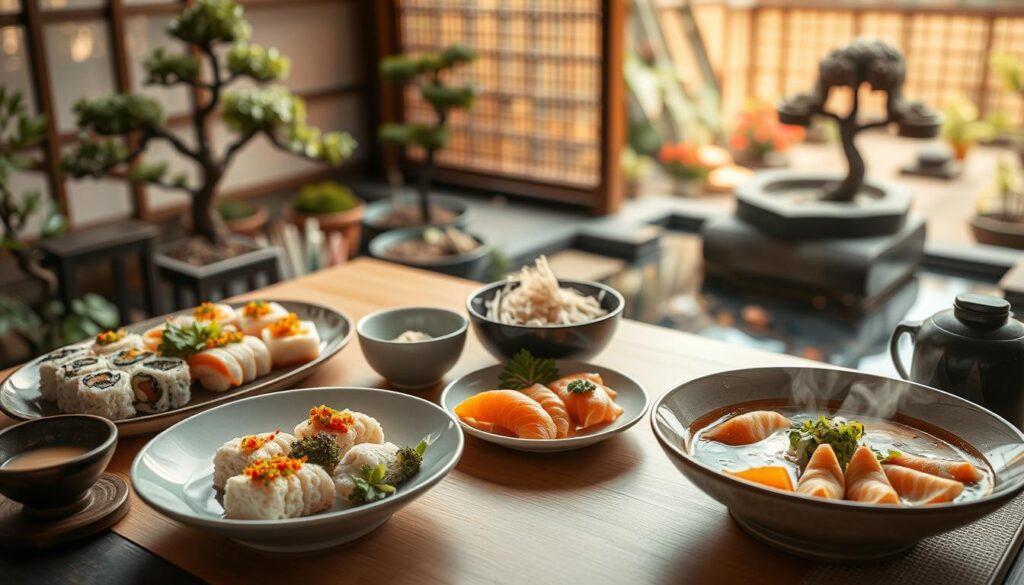
Popular Japanese Dishes You Must Try
When delving into the rich world of Japanese cuisine, several must-try Japanese dishes stand out for their unique flavors and cultural significance. Among these culinary delights, sushi, ramen, and tempura are top contenders that offer a glimpse into the heart of Japan’s gastronomic practices.
Sushi: A World-Famous Delicacy
Sushi has established itself as one of the most recognizable symbols of Japanese cuisine across the globe. With various styles available, including nigiri and sashimi, this dish beautifully showcases the art of balancing fresh fish and seasoned rice. The vibrant flavors and delicate presentation capture the essence of what makes sushi a beloved choice for countless diners.
Ramen: Comfort in a Bowl
Ramen is a staple that embodies the spirit of comfort food in Japan. This delicious noodle dish, typically served in a rich broth, varies greatly from region to region. Notably, Tonkotsu ramen stands out as the most popular type among visitors, offering a creamy pork-based broth that warms both heart and soul. Whether you prefer it spicy or mild, ramen is a quintessential example of a must-try Japanese dish.
Tempura: Crispy and Delicious
Tempura exemplifies Japan’s innovative approach to frying. This dish features lightly battered and deep-fried vegetables or seafood, resulting in an irresistible crunch that delights the senses. Tempura is not only popular among tourists, but also a cherished classic among locals, making it an essential part of any culinary journey through Japan.

The Art of Sushi Making
Engaging in sushi making allows you to create a culinary experience that blends tradition and creativity. As you explore different types of sushi, from nigiri to maki, you’ll learn the techniques that elevate this iconic dish beyond a simple meal. Mastering sushi preparation can be both an enjoyable and rewarding endeavor.
Different Types of Sushi to Explore
Sushi presents an exciting variety of forms. Here are some of the admired options:
- Nigiri: A delicacy consisting of a small mound of vinegared rice topped with fresh fish, showcasing the chef’s artistry.
- Maki: Rolled sushi wrapped in seaweed, which can include a range of ingredients such as cucumber, avocado, and various seafood.
- Sashimi: Thinly sliced raw fish served without rice, highlighting the freshness of the ingredients.
Essential Ingredients for Sushi Lovers
Creating delicious sushi at home requires sourcing high-quality ingredients. Essential components include:
- Sushi rice: A short-grain rice combined with vinegar, sugar, and salt is fundamental for creating the desired stickiness.
- Fresh fish: Salmon and tuna are popular choices, accounting for over 50% of sushi orders.
- Nori: Seaweed sheets provide a wrapping for various sushi types, particularly maki rolls.
Best Tools for Making Sushi at Home
Investing in the right sushi preparation tools significantly enhances your sushi making experience. Essential tools include:
- Bamboo mat (makisu): This tool helps achieve proper rolling technique, essential for maki sushi.
- Sharp knife: Precision is crucial in sushi making, making a quality knife necessary for clean cuts.
- Rice cooker: This makes preparing perfect sushi rice easier, ensuring consistent results.

Appreciating Japanese Flavors
Exploring Japanese flavors offers a delightful journey into the unique taste profiles that define this beloved cuisine. A central element in this experience is umami, often regarded as the fifth taste alongside sweet, sour, salty, and bitter. Understanding how umami enhances culinary seasoning provides key insights into the foundational elements of Japanese cooking.
Umami: The Fifth Taste
Umami, a term originating from Japanese, translates to *pleasant savory taste*. This flavor is primarily imparted by ingredients rich in naturally occurring glutamates, such as kombu kelp, which is harvested off the coast of Hokkaido. The unique profile of umami can be amplified through umami synergy; for example, pairing kombu with katsuobushi or dried shiitake mushrooms transforms the taste experience. Japanese dishes not only celebrate umami but also exemplify its importance in the overall flavor balance.
The Role of Seasoning in Japanese Cooking
Culinary seasoning in Japan is meticulously crafted, ensuring that the natural flavors of ingredients shine through. Key seasonings such as koikuchi soy sauce and mirin are staples in many recipes. Koikuchi soy sauce brings a depth of umami with a slight sweetness, while usukuchi soy sauce, with a higher salt concentration, serves a specific purpose in balancing dishes. The versatility of mirin, containing essential alcohol due to rice fermentation, also plays a vital role in enhancing umami and overall flavor profiles in various dishes.
Japanese culinary traditions emphasize balance and harmony in seasoning, as reflected in mixtures such as nihaizu and sambaizu. These combinations illustrate the rich diversity within Japanese flavors while contributing to the intricate dance of taste sensations that define the cuisine.
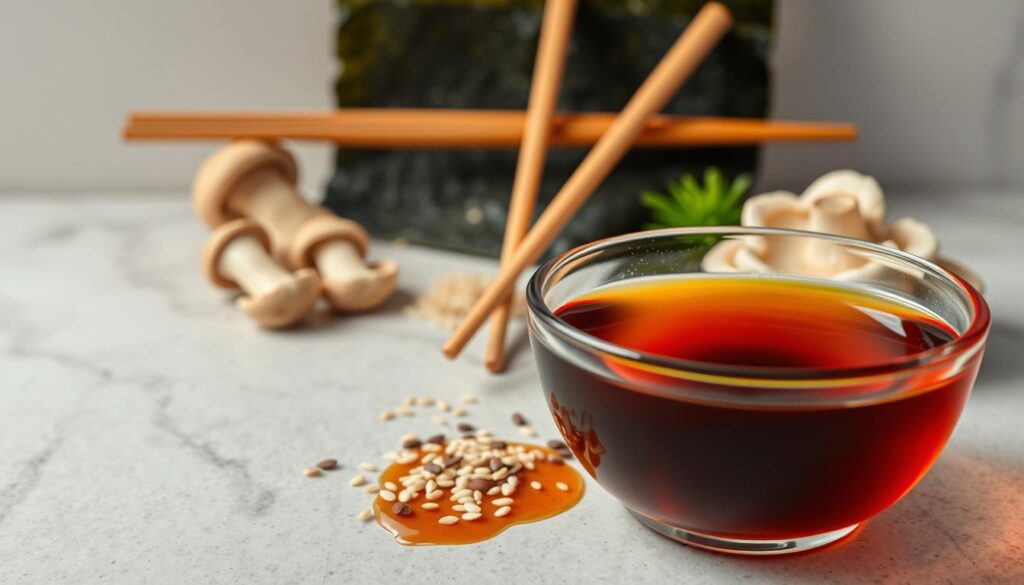
Regional Specialties in Japan
The beauty of Japanese cuisine lies in its rich diversity, with each region offering unique flavors and dishes that reflect local ingredients and traditions. You will find that regional Japanese specialties, known as kyōdo ryōri, showcase the country’s culinary history. Discover the delightful tastes of Hokkaido, famed for its seafood and dairy delights, as well as Kansai dishes like okonomiyaki that provide a savory experience.
Hokkaido: Seafood and Dairy Delight
Hokkaido cuisine stands out for its exceptional variety of fresh seafood and rich dairy products. Enjoy specialties such as Ishikari-nabe, a cozy salmon hot pot, or Genghis Khan, a delightful barbequed lamb dish. This northern region’s access to pristine waters allows for an abundance of high-quality fish, making sashimi an essential part of the culinary landscape.
Kansai: Home of Okonomiyaki
Kansai is synonymous with exciting flavors and hearty meals. The region is particularly famous for its okonomiyaki, a savory pancake that can be customized with a plethora of ingredients, including meats, seafood, and vegetables. The Osaka-style variant incorporates ingredients mixed directly into the batter before grilling, while Hiroshima-style builds layers of flavors with noodles and toppings. Takoyaki, delightful octopus dumplings, also originates from this vibrant area.
Kyushu: Rich and Flavorful Dishes
Kyushu cuisine boasts a treasure trove of flavors that celebrate local ingredients. Famous dishes include tonkotsu ramen, characterized by its rich pork bone broth, as well as gyūtan, a flavorful beef tongue delicacy. Enjoy unique items like mentaiko, a spicy fish egg dish from Fukuoka, and the refreshing taco rice from Okinawa, blending local and international influences seamlessly.
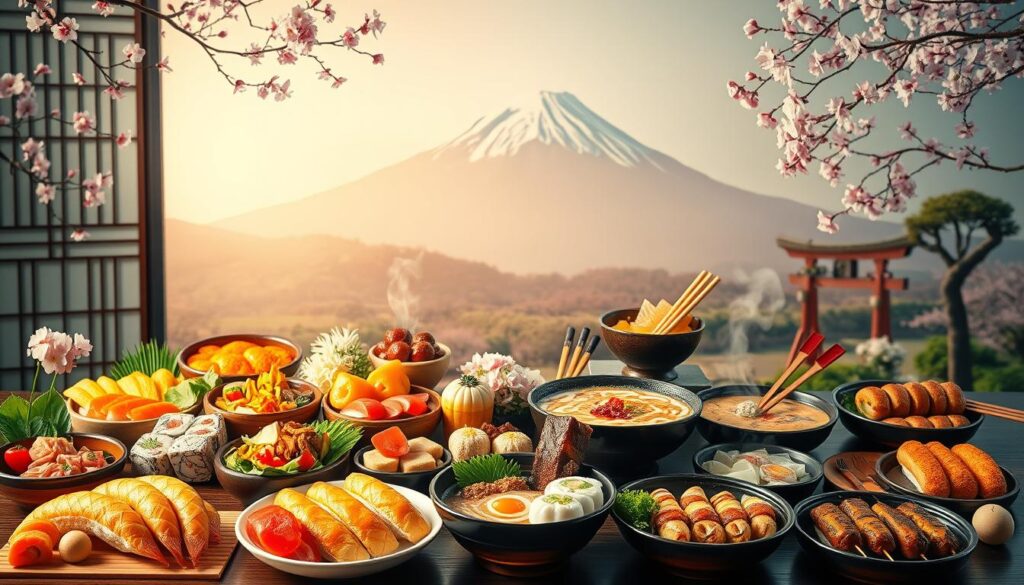
Traditional Japanese Dining Etiquette
Understanding Japanese dining etiquette enhances your experience while enjoying a meal. Observing proper table manners is essential in Japanese culture. Respect for the food and fellow diners plays a significant role in each dining experience. This encourages a harmonious atmosphere where everyone shares appreciation for the meal. Key practices, such as using chopsticks correctly and waiting for everyone’s order before eating, reflect these values.
Table Manners to Observe
When dining in Japan, it’s vital to observe certain table manners. Here are some key points to keep in mind:
- Always say “Itadakimasu” before starting the meal to express gratitude.
- Finish all the food on your plate, including rice, as wasting food is frowned upon.
- Use the wet towel (oshibori) provided for hand cleaning, not for your face or neck.
- Avoid blowing your nose, burping, or making loud chewing noises at the table.
- At the end of the meal, say “Gochisosama deshita” to thank the host for the meal.
- Participate in the “kanpai” toast, waiting until all glasses are filled before toasting.
How to Use Chopsticks Properly
Mastering chopstick use is crucial in Japanese dining etiquette. Here are some guidelines to ensure you get it right:
- Hold chopsticks at the thicker end, allowing for better control and balance.
- Never use chopsticks to pass food to someone else, as this resembles a funeral custom.
- When sharing dishes, use the opposite end of your chopsticks or dedicated serving utensils.
- Do not leave chopsticks sticking upright in rice, as this is considered disrespectful.
- Always return chopsticks to their resting position on the designated place after use.

A Guide to Japanese Beverages
Exploring Japanese beverages unveils a fascinating world defined by tradition and innovation. Each drink tells a story, enriching your culinary experience whether enjoyed alone or alongside a meal. From the iconic sake to the healthful matcha, these beverages are integral to Japanese culture and cuisine.
Sake: Japan’s National Drink
Sake, brewed from rice, has a history dating back centuries, making it Japan’s national beverage. Two primary types exist: Junmai, which contains no additives, and non-Junmai, featuring additional distilled alcohol. Sake flights allow enthusiasts to taste different varieties, which can range from fruity and floral to bolder flavors that pair excellently with various dishes.
Matcha: The Benefits of Green Tea
Matcha, finely ground green tea, is celebrated for its numerous health benefits. It contains antioxidants that support overall wellness and has been a staple in Japanese tea ceremonies since the 9th century. Hot or cold, this beverage remains a favorite, often complemented by traditional sweets.
Shochu: A Unique Spirit to Try
Shochu, a distilled spirit with a unique flavor profile, is gaining popularity in Japan. Typically made from sweet potato or barley, it has an alcohol content of 25-30%. Its versatility allows it to be enjoyed neat, on the rocks, or in cocktails, making shochu a delightful addition to your Japanese beverage exploration.

Exploring Japanese Desserts
The world of Japanese desserts is a vibrant tapestry of flavors, textures, and traditions. You’ll discover a delightful variety that showcases the artistry and cultural significance of sweets in Japan. From the chewy texture of mochi to the elegance of wagashi, each dessert tells a story of seasonal ingredients and craftsmanship.
Mochi: Chewy and Sweet
Mochi is a beloved staple among Japanese desserts, characterized by its unique chewy texture. Made from glutinous rice flour, it can take on various flavors and fillings, such as anko (sweet red bean paste) or seasonal fruits. Popular variations include sakuramochi, often enjoyed during cherry blossom viewing, and yuzu mochi, which brings a citrusy twist during winter months. Many celebrations and festivals in Japan highlight the importance of mochi, often symbolizing good fortune and abundance.
Anmitsu: A Refreshing Treat
Anmitsu is a delightful dessert that combines different textures and flavors in one bowl. Typically served with chewy mochi, agar jelly, and an assortment of seasonal fruits, it is drizzled with a sweet syrup, making it both visually stunning and refreshing. This dessert is popular during the warmer months, providing a cooling treat while emphasizing the beauty of seasonal bounty.
Wagashi: Traditional Japanese Sweets
Wagashi encompasses a wide range of traditional Japanese sweets that are often enjoyed during tea ceremonies, especially with matcha. These meticulously crafted treats reflect Japan’s commitment to seasonality, with each piece designed to highlight the changing colors and flavors of the year. From the delicate monaka crafted by Kuuya in Ginza to the intricately shaped yatsuhashi from Kyoto, wagashi offers a sensory experience that engages both the palate and the eyes. Understanding wagashi opens a window into Japan’s cultural heritage and culinary sophistication.
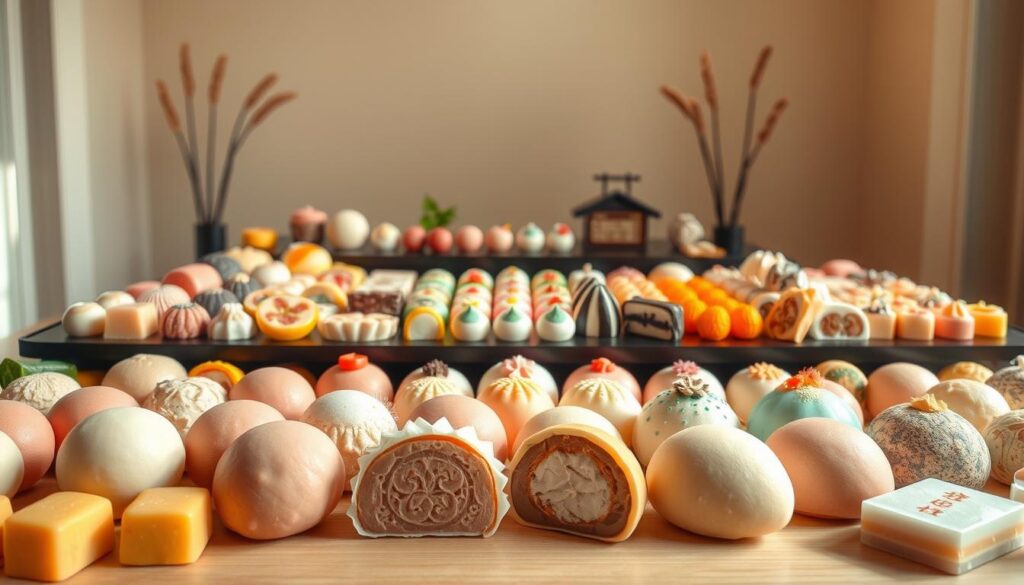
Understanding Japanese Ingredients
Japanese cuisine is celebrated for its fresh, high-quality ingredients that provide rich flavors and nutritional benefits. As you delve into this culinary world, becoming familiar with essential pantry staples is vital for authentic cooking. These ingredients serve as the foundation for many beloved dishes, showcasing the balance and depth characteristic of Japanese flavors. Notably, rice plays a central role in this cuisine, often considered a cultural emblem. Below, discover the key components that define Japanese cooking.
Essential Pantry Staples
- Soy sauce: This fundamental flavoring not only adds a savory touch but often replaces salt in many recipes.
- Miso paste: Made from fermented soybeans, it brings umami to soups and broths, being a vital ingredient in miso soup.
- Mirin: A sweet rice wine, mirin adds a touch of sweetness to dishes, enhancing flavor in soups and dumpling fillings.
- Rice wine vinegar: Essential for seasoning sushi rice, it’s made with a balance of sugar and salt mixed into rice vinegar.
- Kombu: Dried seaweed that is crucial in preparing dashi stock, selected for its aged flavors.
- Bonito flakes: Shaved flakes from dried tuna, frequently used to enrich dashi with a robust umami taste.
- Nori: A dried seaweed, perfect for wrapping sushi rolls or as a ramen topping.
- Wakame: This seaweed is commonly found in miso soup, prized for its subtle flavor and health benefits.
The Significance of Rice in Japanese Cooking
Rice is not only a primary food source in Japan but also a symbol of the nation’s agricultural heritage. The short grain variety is preferred due to its sticky texture, making it perfect for chopsticks and dishes like sushi and onigiri. Throughout history, rice has held a sacred status in Japanese culture, representing prosperity and well-being. It appears in many forms, including:
| Type of Rice | Description |
|---|---|
| Sushi Rice | Short grain, seasoned with vinegar, used in sushi. |
| Onigiri Rice | Similar to sushi rice but often shaped into triangles or balls. |
| Rice Cakes | Made from glutinous rice, widely enjoyed in soups and snacks. |
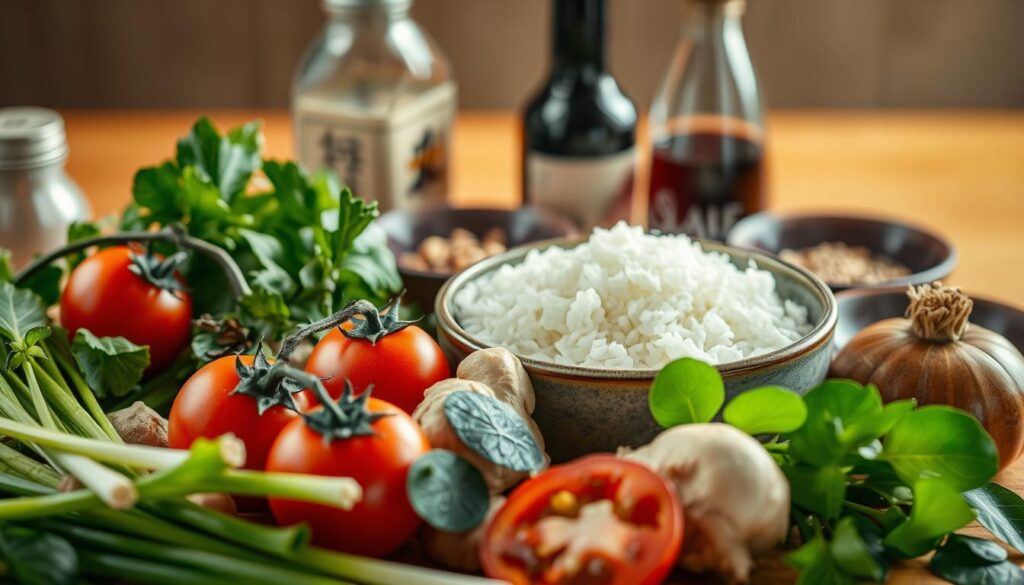
This distinctive rice culture reflects the broader significance of Japanese ingredients, uniting tradition and innovation within every dish. Understanding these components empowers you to create authentic Japanese meals in your own kitchen.
Dining Out in Japanese Restaurants
Embarking on a culinary adventure through Japanese cuisine can be incredibly rewarding. When dining in Japanese restaurants, it is crucial to look for venues that emphasize authenticity. Pay attention to places specializing in specific dishes, such as sushi bars or ramen spots. This approach ensures you savor genuinely prepared dishes that reflect the depth of authentic Japanese cuisine.
Finding Authentic Japanese Cuisine Near You
Many Japanese restaurants embrace tradition, which is evident in their menus and dining styles. Often, establishments display plastic or wax replicas of their dishes, making it easier to select exactly what you desire. In recent years, the anti-smoking law has influenced dining environments, with most places now offering smoke-free options. Expect complimentary water or tea upon seating, creating a welcoming atmosphere as you prepare to enjoy your meal.
What to Expect in a Traditional Ryokan
A stay at a traditional ryokan can deepen your understanding of Japanese hospitality. Usually, guests can indulge in kaiseki, a multi-course dining experience that highlights seasonal ingredients and artistic presentation. Enjoy the beauty of each dish, from sashimi to grilled items, showcasing meticulous preparation. Tipping is not common, but diners often express their satisfaction with a simple “gochisosama deshita” as they finish their meal. This cultural insight into dining in Japanese restaurants makes for an unforgettable experience.
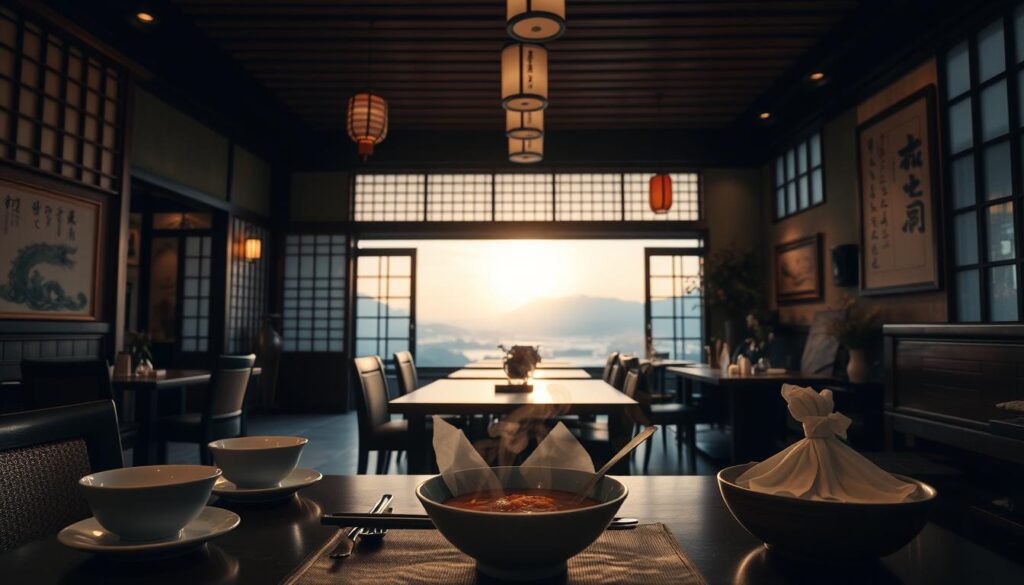
Cooking Japanese Cuisine at Home
Cooking Japanese cuisine at home offers a fantastic opportunity to explore delicious flavors while trying out beginner-friendly recipes. You can start with simple yet satisfying dishes that require minimal time and effort, allowing you to build confidence in the kitchen. With only a few quality ingredients, you can recreate the essence of Japanese cooking right in your own home.
Easy Recipes for Beginners
Try your hand at a variety of easy recipes, such as:
- Miso Soup—A quick and comforting dish that can be made in less time than frying an egg.
- Onigiri—These rice balls are simple to prepare using Japanese short-grain rice for the perfect sticky texture.
- Teriyaki Chicken—Using genuine teriyaki sauce made from soy sauce, mirin, and sake elevates this dish beyond supermarket versions.
- Japanese Fried Rice—Completing this dish takes under 20 minutes and makes for a great use of leftover vegetables.
- Oyakodon—This comforting chicken and egg dish can be ready in just 30 minutes.
Tips for Perfecting Your Presentation
Japanese cuisine places a strong emphasis on aesthetics. Follow these tips to enhance your dish presentation:
- Use beautiful tableware to complement the colors of your dishes.
- Arrange ingredients thoughtfully to create an inviting visual display.
- Practice plating techniques, allowing you to showcase your culinary creations in an appealing manner.
- Experiment with garnishes like shiso leaves or sesame seeds to add flair.

Incorporating Japanese Cuisine in Your Lifestyle
Integrating Japanese cuisine into your daily meals can enhance your overall well-being. Focusing on meal planning with Japanese flavors not only brings variety but also promotes a balanced diet. Fresh ingredients play a crucial role in this culinary tradition, emphasizing the concept of “shun,” which prioritizes seasonal produce. This approach contributes positively to your Japanese cuisine lifestyle by ensuring you enjoy ingredients at their peak freshness.
Meal Planning with Japanese Flavors
To immerse yourself in the delightful world of Japanese cooking, start by incorporating seasonal vegetables, fish, and fermented products like miso and soy sauce into your diet. You can discover numerous recipes that reflect the intricate balance and umami-rich flavors characteristic of Japanese cuisine. Consider how you can structure your weekly meals to include:
- Fresh sushi rolls with seasonal vegetables.
- Hearty ramen packed with nutrient-rich broth and toppings.
- Flavorful tempura, offering a variety of crispy textures.
By planning your meals around these components, you can create dishes that not only satisfy your taste buds but also support your health.
Health Benefits of Japanese Diet
The traditional Japanese diet is celebrated for its health benefits. Packed with vegetables, seafood, and fermented foods, this way of eating may lead to improved digestion and heart health. Below are some notable benefits you can expect when adopting a Japanese cuisine lifestyle:
| Health Benefit | Details |
|---|---|
| Improved Digestion | Fermented foods such as miso and pickles promote gut health. |
| Heart Health | Rich in omega-3 fatty acids from fish helps reduce inflammation. |
| Balanced Nutrition | The variety of ingredients ensures a well-rounded intake of nutrients. |
By embracing these elements in your lifestyle, you can enjoy not just the flavors of Japanese cuisine but also the wide-ranging health benefits that accompany this delicious and nourishing diet.

Japanese Cuisine and Its Global Influence
The global influence of Japanese cuisine has transformed dining experiences around the world. This unique cuisine, known for its emphasis on seasonality and freshness, has led to innovative fusion dishes that merge traditional Japanese flavors with American culinary practices. As you explore this vibrant gastronomic landscape, you’ll discover how Japanese-American fusion captures the essence of cross-cultural culinary adventures.
Fusion Dishes: Japanese Meets American
Japanese-American fusion has gained a notable following, with dishes that creatively blend elements from both cultures. Signature offerings include:
- Sushi Burritos: A portable take on traditional sushi, wrapped in seaweed and filled with vibrant ingredients.
- Ramen Burgers: Savory patties sandwiched between ramen noodle buns, bringing together comfort food from both cuisines.
- Matcha Desserts: From ice cream to cakes, the rich flavors of matcha have captivated dessert lovers.
These inventive creations reflect the broader trend of incorporating the global influence of Japanese cuisine into everyday meals. You can find such dishes at restaurants in major cities like Los Angeles and New York, illustrating the enormous appeal of this culinary fusion.
The Rising Popularity of Japanese Foods
Japanese foods have continued to rise in popularity across the globe. Sushi, ramen, and matcha have become household names, often featured in various culinary contexts. Notable trends include:
- The increased availability of authentic sushi restaurants in cities worldwide, serving both traditional and contemporary styles.
- Widespread adoption of ingredients such as edamame, tofu, and miso in non-Japanese cuisines, promoting plant-based diets.
- Innovative interpretations of classic dishes, showcasing the seamless integration of Japanese techniques with global flavors.
As you navigate this exciting culinary world, the global influence of Japanese cuisine will undoubtedly enhance your dining experience. Discover the rich tapestry of flavors and ideas that define Japanese-American fusion, showing how cultural exchange enriches our plates.

Conclusion: Embrace the Delights of Japanese Cuisine
Exploring the culinary delights of Japanese cuisine offers you a chance to enrich your own cooking repertoire with a variety of flavors and techniques. From the simplicity of basic ingredients to the intricate presentations of traditional meals like kaiseki, each dish tells a story rooted in cultural significance and appreciation for seasonal ingredients. The emphasis on harmony, encapsulated in the term 和食 (washoku), reveals the Japanese philosophy of balance that permeates their culinary practices.
As you embark on your culinary journey, you’ll find opportunities to savor iconic dishes such as sushi, ramen, and tempura. By embracing these traditional flavors and incorporating them into your daily meals, you can not only enjoy healthier eating habits but also appreciate the natural tastes that Japanese cuisine celebrates. Whether you’re dining out at a specialized restaurant or attempting easy recipes at home, you’re invited to explore Japanese food in all its glory, unlocking a world of gastronomic adventure.
Ultimately, the cultural richness and innovative spirit alive in Japanese cuisine encourage you to take part in a dining experience that goes beyond mere sustenance. By reflecting on customs like itadakimasu and engaging with seasonal ingredients, you can cultivate a deeper connection with the foods you consume, making every meal a delightful celebration of life’s flavors.
